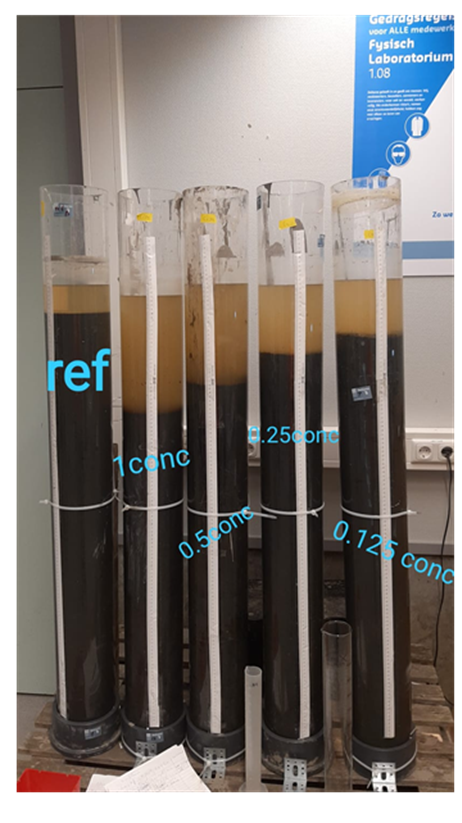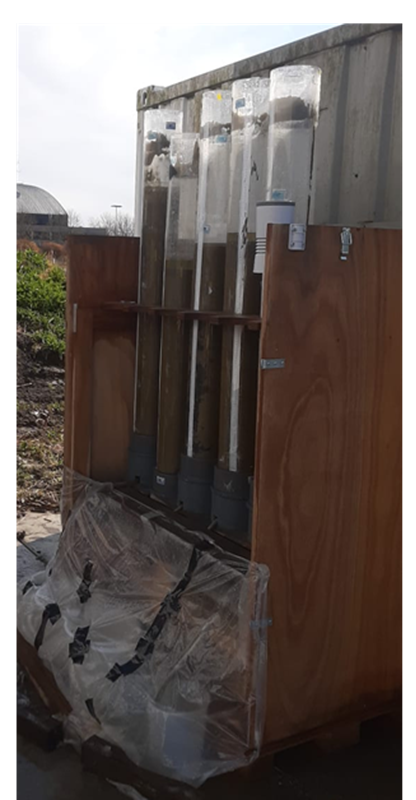In this page we present a general overview of the project. It was our partners preference to keep their operational information outside of the results overview. Nevertheless all the knowledge advanced in this particular application is public and described as follows:
1. Context and primary goal
The project W:StS is called to develop a technology that will enable Port and Navigational Authorities (and potentially other Authorities managing fine sediments) to rapidly transform dredged sediment into soil. The project takes place as a collaboration between Deltares, Haedes, and the problem owner Envisan. Currently sediment dredged from Gent-Terneuzen Canal is stored in lagoons at the sediment treatment plant of Envisan for their dewatering at drying fields. This dewatering takes months, with usually one individual lagoon being able to treat just two to three sediment batches per year. Preliminary tests funded by Deltares and executed in collaboration with Envisan and Haedes have demonstrated that a certain species of worms, when added to the sediment in the correct proportion and conditions, have the potential to speed up this process up to a factor 12 in laboratory conditions (further information on the performance of the technology at a laboratory scale is available, but protected by a NDA). Nevertheless the latter was obtained for an initial sediment thickness of only 70 cm, which is smaller than typical thicknesses in the field, and in the absence of weather conditions.
The main objective of the current project is to update optimization performance of the technology for a set of conditions that are closer to application. The latter was materialized via the execution of a set of experiments, going from laboratory tests at Deltares (indoors and outdoors), to scale models at the facilities of Envisan. The overarching goal or objective of this project is to develop a technically efficient, economically attractive but most importantly sustainable method to convert sediment into soil at a large scale, contributing to release the pressure in the sediment management and disposal cycle. Our method is passive and would decrease the use of machinery used for drying of the sediments (not for the particular engineering application discussed here, but in other sediment disposal operations drains and compaction is used; our technology would also constitute a sustainable alternative here). We also expect to have a positive impact in decreasing methane emissions due to the worms ability to oxidize the sediment rapidly. This project is expected to develop the concept of W:StS, which will constitute an improvement to existing methods to transform sediment into soil.
2. Research questions
As mentioned in the previous section the main objective of the current project is to update the optimization performance of the technology for a set of conditions that are closer to real life application. In particular, the following individual research questions will be addressed:
1) What is the effect of varying worm concentrations (e.g. is there room for optimization when applying the technology in real conditions)?
2) What is the effect of precipitation and temperature variations?
3) What is the effect of the application method of worms into the sediment (e.g. at depth versus at the surface)?
4) What is the effect of increasing the horizontal cross-section and the total volume of sediment treated?
3. Results
3.1 Assessment of research question 1
1) What is the effect of varying worm concentrations (e.g. is there room for optimization when applying the technology in real conditions)?
The larger the concentration of worms, the faster the observed initial dewatering. Nevertheless, after some time, consolidation becomes equal for all the studied concentration of worms, and larger than the consolidation of the reference test. If the target SC is smaller than the SC at which all worm concentrations convey, a larger concentration of worms will help in achieving the target SC earlier. If otherwise the target SC is larger than the SC at which all worm concentrations convey, using our reference concentration of worms is as efficient in reaching earlier the target SC as 1/8 of our reference concentration of worms. The latter implies that there is at least a factor 8 room for financial optimization. The strengths delivered by worms do vary as a function of worm concentration, even at equilibrium. Therefore, in a system solely driven by strength, the larger the initial concentration of worms, the earlier the target strength will be reached.
3.2 Assessment of research questions 2 and 3
2) What is the effect of precipitation and temperaturevariations?
In general, and despite the abundance of rain during our study period, higher SC and larger densities are achieved when exposed to weather conditions. The latter was visible for both worm treated and non-treated samples, but worm treated samples continued to exhibit the largest SC and density values and maintained a comparable positive gap with non-treated samples. Worms do not show a clear effect on enhanced evaporation during dry periods, but do decrease the negative effect of rain by quickly creating compact beds that are less vulnerable to density variations due to air pores being filled with water during rain. Temperature was not directly monitored, but the low temperatures over the first weeks of experiment (it was March 2021) are assumed to have affected negatively the worms performace (at the weeks where its effect is mor relevant).
3) What is the effect of the application method of worms into the sediment (e.g. at depth versus at the surface)?
Initially, there seems to be a clear positive effect of the application method, with the mixing method consistently showing faster densification. With time, the different application methods and worm concentrations tested convey into an equivalent dewatering and densification, justifying its application in practice only when fast results in the order of weeks are needed.
3.3. Assessment of research question 4
4) What is the effect of increasing the horizontal cross-section and the total volume of sediment treated?
Testing the technology in larger volumes and exposed to weather conditions resulted in the largest SC profiles and shear strengths profiles in equilibrium measured throughout the entire project. The Deltares outside columns resulted in the largest SC throughout all Deltares tests. The Envisan cubitainers resulted in even larger SCs. The consolidation of the reference experiment did not change when increasing the volume to be treated, whereas the worm treated samples did result in better performances when increasing the volume to be treated.
Moreover, the Envisan columns exhibited faster developments of large SC and large shear strengths than the reference. Taking for example a typical specific SC in operations, worm treated samples reach it after 40 days, whereas the reference reaches them after 80 days. This is consistently observed in both the evolution of depth-averaged SC as a function of time and the SC profiles. Taking a certain strength in kPa as a reference, worm treated samples start exhibiting this strength at the 94 days profiles (20 to 40 cm). The reference experiment only reaches these strengths at the very bottom of the cubitainers in the 121 days profiles. At that point, worm treated samples exhibit the strength in question over 40 cm of bed.
4. Conclusions
The research questions have been assessed in detail over the results section of this report, and are synthetized over the following lines again:
1) What is the effect of varying worm concentrations (e.g. is there room for optimization when applying the technology in real conditions)? The concentration of worms positively affects initial dewatering, but all worm treatments end up conveying into a certain equivalent SC after 2 months (which is only reached at the end of the tests for the reference sample). This means that 1/8 of our standard concentration of worms managed to deliver the same SC and density improvements as our reference concentration, providing room for financial optimization of the technology.
2) What is the effect of precipitation and temperature variations? In general there is better dewatering when exposed to weather conditions, with or without worms. Worms do maintain their positive effect in dewatering over no worms, with the increased SC in absolute value being equivalent as these observed inside the laboratory. Another positive effect of worms is that their initial fast consolidation protects the bed from swelling upon precipitation, which seems to be characteristic of low SC.
3) What is the effect of the application method of worms into the sediment (e.g. at depth versus at the surface)? The mixing method dominates over the concentration of worms over the first days of dewatering, results converge after a certain SC is reached (within the first month for outdoor conditions).
4) What is the effect of increasing the horizontal cross-section and the total volume of sediment treated? Increasing the volume to be treated results in no apparent difference in consolidation and strength development from obtained with the Deltares columns, for the reference experiment. With worms, increasing the volume to be treated resulted in a slightly larger larger equilibrium SC and a larger equilibrium strength profile. Consolidation was also faster than in the columns, with a cerain SC relevant for operations being reached only after 40 days of tests (in contrast to the 60 days or more for the columns). The latter is remarkable given the larger initial thickness at the cubitainers,

